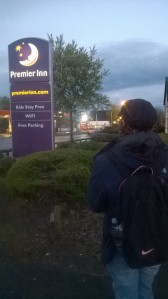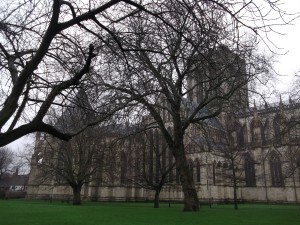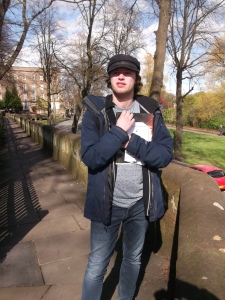
Arriving
It’s not surprising that Dylan likes Premier Inns: the rooms are identical, the facilities standardised and the buildings similar in style. Such predictability can be enabling; I’m not sure Dylan would be as relaxed as he is away from home without the reassuring familiarity of a ‘moon hotel’. When we arrived at a Premier Inn last weekend, however, I was shocked; the twin room wasn’t configured in the same way as those we had stayed in previously and the narrow space between the beds made them feel more like a double.
In the context of a mother and adult son the room wasn’t acceptable. Dealing with the situation, however, was potentially tricky; Dylan was already looking around, working out where to put his things. If I were to do something about the situation I had to act quickly. I managed to persuade Dylan to leave bags unpacked while we returned to reception. It was a holiday weekend and as I had struggled to find accommodation for the evening I wasn’t confident about my chances but, keeping my voice cheery so as not to make Dylan anxious, I explained the problem with the room.
Once again I was struck by how improved autism awareness is; the staff instantly understood the situation and dealt with it beautifully, identifying potential solutions and involving Dylan in the process. Would Dylan like to view an alternative room, one of the receptionists asked? We followed her up the stairs where we were delighted to find a larger room with a bed by the window for Dylan. I am sure that involving Dylan in this way helped him to understand the situation; had I simply negotiated the room change at the desk then returned to the original room to retrieve our bags he would probably have thought we were leaving and become anxious. With the visual support of visiting the alternative room, however, Dylan accepted the change without a problem.
*

Departing
This turned out not to be the only disruption to routine Dylan had to cope with; returning to our room after a meal out I discovered I couldn’t get Brave to play on his ipad mini. As I mentioned in my last post, the ipad mini is a new acquisition. I haven’t used it for Facetime with Dylan yet as I am still trying to get myself up and running with Dylan’s old ipad. I thought, however, that I’d managed to transfer Dylan’s music and films across to the mini and that all was well. ‘You can watch a film on your new ipad when we get back to the moon hotel’ I had said to Dylan as we left the restaurant.
Fortunately I managed to distract Dylan with a bath when Brave wouldn’t play as promised. The next morning I managed to head off a repeat request with the suggestion of breakfast. I had figured out that the films Dylan used to have on his old ipad were ‘in the cloud’ on his new mini; rather than available to him at all times these are now dependent on Dylan having an Internet connection capable of downloading them (which the hotel’s free Wi-Fi service was not). This is not ideal and will be very confusing for Dylan who was previously able to watch whenever he wanted. For his technophobe mother, meanwhile, it’s another argument against life’s unremitting upgrades.
*

York Minster
Last weekend’s ‘moon hotel’ was in Chester, a place neither Dylan or I had visited before (except for trips to Chester Zoo which hadn’t involved driving into the town centre). When introducing Dylan to new experiences it is useful to make a connection with things which are already familiar. This is true of all learning, of course, but seems to be particularly the case for Dylan who embraces new experiences happily, with confidence, when they are grounded in something he already knows. So my reason for taking Dylan to Chester was the town’s similarity to York, Dylan’s favourite place in the world.
As I have noted before, Dylan has been visiting York for years; he recognises and collects information about York, says the word ‘York’ beautifully, and spends much of his time looking at pictures of York. Part of this attraction is the Minster but recently I’ve realised that of even more interest to Dylan are York’s city walls. We have developed a hand sign for city walls which involves drawing a horizontal circle in the air; ‘York’ Dylan says to me optimistically, tracing a flat ring with his finger. Surely, I told myself as we drove into Chester last Saturday morning, Dylan would love it; there was a cathedral, a railway, a river and city walls, just like at York.

Chester Cathedral
Serendipitously we found a mobility car park (hats off to Chester Council) at the entrance to the Cathedral and city walls. Dylan was on alert; he had the quick look about him that means something has caught his attention. As I switched the car engine off I turned to him and drew a circle in the air; ‘there are city walls here’ I said. I didn’t need to tell Dylan; he had already clocked them. As we emerged from the car park into a stained glass dazzle of light I wondered if Dylan might head into the Cathedral first? But no: off he tore, anti-clockwise, around the walls.
*

City Walls, Chester
Perhaps Dylan likes city walls because the way they encircle an area is intuitive to him and feels comforting. When Dylan was very young – before we realised he was autistic – one of the things he did was stake out perimeters. It’s quite a common behaviour among autistic children: lining objects up around edges, creating boundaries. Before I knew it wasn’t playing I used to smile at Dylan’s imaginatively-placed bricks and cars and tea set pieces. The first time I remember puzzling at it was on holiday in France when Dylan was 16 months old. As we only had a few toys with us Dylan emptied the kitchen cupboards of pots and used those instead. I have a memory of watching him scratch his head like an old man as he surveyed a border he’d built around a room with cups and plates and saucers. There was something about it that didn’t seem right.
Looking back I can see that being taken into a new environment with differently-configured space must have been very confusing for Dylan. With no knowledge of his autism, I wasn’t looking out for Dylan or mediating the world for him as I do today. For the undiagnosed child, the world must seem a very scary place indeed. Now I can smile because I understand that Dylan’s attempt to impose order on the holiday cottage was smart; he found the pots, on his wobbly toddler legs, and did his best.

River Dee, just outside the Walls
Later, I would watch Dylan mark territory with his body: pacing the edges of a library or art gallery; establishing a boundary in a park or field; setting himself limits when visiting friends. ‘It’s alright’ I would say, ‘once Dylan fixes his boundary he’ll keep within it’. It is a way of mapping but also a safety mechanism; when Dylan has paced a border, or marked a route, he seems to feel less anxious about inhabiting the space. I think this is partly about his location in relation to others but is also about his embodied self; he needs to know where he is in relation to himself as much as to the outside world.
*

Dylan with his book
As well as visiting Chester Cathedral we visited St John the Baptist’s Church, Chester’s original Cathedral. There was a second hand book sale in the church and Dylan went rummaging, returning with a Thomas the Tank Engine book (no surprise) and a coffee table book (which was unusual). ‘What is that you’ve got, Dylan?’ I asked, pointing to the large book under his arm as I helped him find his purse. ‘York’ he replied. The book was called ‘Colourful Britain’ and had photographs of various iconic locations in Britain. The reason Dylan wanted the book was the photo of York Minster on the cover.
Was Dylan making an explicit link between the town we were visiting and his beloved York? Could his experience of somewhere strange be helping him re-think the familiar? As I wondered this I recalled how, at Dylan’s age, I had spent a year in the USA as part of an exchange programme. As Christmas approached one of my English peers felt so homesick she decided she would go home for Intercession. I hadn’t settled either but I didn’t want to spend money on a round trip flight to England; I decided to go travelling in Mexico instead.

Magnolia, Chester Cathedral Garden
Those weeks turned out to be some of the most difficult of my life; I got into scrapes I shiver to recall 35 years on. But one of the positive things that came out of the experience was that when I made it back to the University of Massachusetts it felt different. I remember how relieved I was to see the vast campus (which before Christmas had seemed so alien) and hear the American accents telling me they would see me later (which had seemed unintelligible before but was now reassuringly familiar). It was wonderful to be back, I told my friend Nettie: it was as if I’d come home.
*

Water of Life (Garth, 1992)
Before we set off to drive back over the Pennines on Saturday evening I showed Dylan his programme for the next day and week ahead. The plan was that I would return Dylan to his residential setting but I wasn’t sure whether Dylan would accept this; usually I see him Saturday/Sunday at home rather than Friday/Saturday away from home. I pointed at the symbols and photographs and tried to explain, reassuring Dylan that he would see me as usual the following weekend. I fell silent, wondering if he had understood. Dylan looked at his programme and pointed to the photo of our house: ‘Home’, he said to me.
This is the first time Dylan has said ‘home’ unprompted. I have never been sure whether or not he understands the word or knows where home is – and since Dylan moved to residential care I have become even more confused about this. Should I call his care home ‘home’, I have asked myself, or the house where we used to live together and which he now only visits? I have kept fudging this, never quite sure what to say. But Dylan seems to have it figured out. Perhaps moving to residential care has given Dylan a stronger sense of home in the same way that I came to appreciate the familiar through the strange at his age?
‘Yes Dylan’, I replied: ‘That is our home’.


Wow, great report, nice pictures, and some surprises to me: how the ‘Moon hotel’ attendant managed the room situation, and how you’ve dealt with the “home” unexpected answer… Loved it all!
Best regards
Eder
LikeLiked by 1 person
Thank you Eder!
LikeLike
Every time I read your posts, i have tears arrive in my eyes! I think it is because I recognise what you talk about in a way that is difficult to find. I think the tears are mostly because of a feeling of joy at finding that recognition. Not sure yet. Thankyou for your stories.
LikeLike
And thank you for reading and for sharing your tears. I understand about them maybe being joy and maybe something else – tears can be bittersweet, x
LikeLiked by 1 person
There’s so much in this post to comment on that I probably need more time to digest it. One thing I’m finding is that the tales of your adventures with Dylan are, if anything, even more fascinating, now that you’re living apart from him. It seems to be giving your time together even more significance. There is a clarity about an autistic perspective in these posts that is startlingly fresh. Keep posting, Liz.
LikeLiked by 1 person
Thank you for saying that Caroline – I have been a little unsure whether I would have any new or useful observations about Dylan now that I see so much less of him. I thought my posts could only be about me now – about the impact of the separation on my life and my feelings for example – so it was interesting to me last weekend to have a new thought about Dylan (linking his boundary pacing with walls). I’m glad you found it interesting too 🙂 It has helped reassure me that just because Dylan lives elsewhere it doesn’t mean that I will lose what I like to think of as my intuitive connection with him. So thanks for the encouragement and I will go on with this blog a little longer I think… x p.s. as you will see our recent chat about ’embodiment’ and your work with young children influenced my thinking about Dylan’s relationship with physical space…
LikeLiked by 1 person
It was very interesting to read about you considering what home means to Dylan. My son has recently started to weekly board at school and I have struggled hugely with the transition, wondering what it means to him and how it has changed his perception of us, his family and where he belongs. I very much enjoy reading your blogs which I have come to quite late really. They were recommended to me when I was feeling very isolated from parents of more able children with autism.
LikeLiked by 1 person
Hello Natasha – it’s good to hear from you. I can imagine how you are feeling. I have found it very difficult to adjust to Dylan living away not just from my own perspective but, as you say, wondering what sense he makes of the situation. Dylan comes home each weekend so it is very similar to your son’s pattern of weekly boarding. It is almost a year now but I am only just beginning to face some things, such as this issue of ‘home’. It’s interesting you should mention isolation from other parents – I’ve been thinking a lot about this issue recently (things that are different and things that are shared by children across the spectrum and their parents). I find it quite challenging but perhaps I’ll try and write about it at some point. Thank you for reading 🙂 Liz
LikeLike
Pingback: Kissing The Screen | Living with Autism
Your observation of the importance of boundaries confirms something I have seen while running Forest School sessions with children of mixed abilities. Teachers who were insecure at having class out of school premises wished for boundaries and I asked the children to explore with me and create a safe boundary. The autistic member of the group specified he wanted stripy tape marking all round the site, tree to tree to be sure of his boundaries. Next week I asked if the children recalled the Forest School site boundaries. Most said they did. I asked if anyone would like a visual signal of the tape and our fellow said yes he would. He then partnered with a very able child to mark the boundary with stripy tape to his satisfaction, which meant, this time, round trees at changes of direction. Thereafter he needed no tape but walked the boundary. Its important to allow people to feel secure and have limits and safe spaces.
LikeLike
What a wonderful story! It is a lovely example of how we all need boundaries in different ways and that we have different ways of ‘fixing them’. Marking them physically with our bodies, or with sticky tape, is just another variant of what many of us probably do internally. Interesting that you should give a Forest School example; at work (in a University Education Department) we have recently started placing students in Forest School settings (for work-based learning) which is proving very rich in terms of developing the knowledge they acquired earlier on the course in a module focused on ‘Educational Spaces (including beyond the classroom). The story you tell here is a lovely example of how observations in such a setting can also develop our understanding of individual difference 🙂
LikeLiked by 1 person